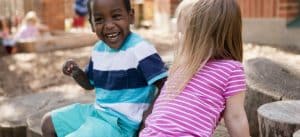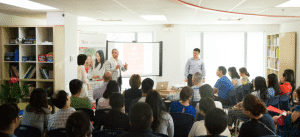By Trish Irvin
We welcome Scott Morgan, M.A. Sc. (Elec. Eng.) to the KEY team as the lead player, and we mean player in every sense of the word, for the electrical engineer and math magician, brings to our summer camp program a love of robotics and wealth of experience in sensors and actuators. Serious about achieving results in life, wait until you hear what Scott has to say about playing around with robots.
Q: How did you first get involved in the world of robotics?
A: I have a background in electrical engineering and math and graduated with dual Honours degrees in Math and Electrical Engineering from UBC. I grew up in Montreal and moved to Vancouver at the age of 17. I was a high school dropout but got admitted into VCC’s electronics program basically because of my natural aptitude for math. I aced the qualifying exam, thanks to a professor who had given me a pre-calculus book. When I graduated I was awarded the Dean’s medal for earning a perfect 4.0 GPA. At the age of 23, I got into Capilano College, did two years of science there, and then transferred to UBC. While studying, I worked as a programmer and electronics technician at VCC to pay my way through university. I earned my Masters in Applied Science from UBC while working for Honeywell. I’ve always been interested in specialized control theory and design, and working in paper mill control systems for Honeywell proved to be a rewarding career for me. Robotics is just an extension of my interest in that work.
Q: How did you end up becoming a teacher?
A: I naturally gravitated towards teaching. As part of my job as an engineer, I was head of the training and services department for Honeywell, teaching high-level paper machine control systems to company engineers all over the world. Making paper is a complex process and Honeywell is an international company at the top of its field. I gave classes throughout Southeast Asia, Europe, and the United States, teaching control systems to engineers.
I studied robotics in university as well as working part-time as an assistant on a project that was aimed at simplifying the controls on the type of excavators used for digging holes. We worked on replacing the complex system of hydraulic controls with a joystick. The technology was useful because the joystick gave tactile force feedback for the operator.
I was also involved in the VSB Science in Residence program where I worked with teachers, helping them develop science criteria and hands-on labs. I was involved in developing curriculum as much as teaching teachers about electricity, breaking it down for them so they could be more effective teachers.
Q: What will students be doing in KEY’s summer robotics program?
A: Teaching robotics is about more than math. I’ll be teaching youngsters about problem-solving and collaboration which are life skills that will serve them well for the rest of their lives. More than that, robotics is a fun way to learn how to interface sensors and motors and solve real problems. Image recognition is a big part of what robots have to do and that’s what our students will be primarily learning. They will focus on programming the robot, not operating it by remote control. Robotics is about automating processes. It’s about transferring some of your own intelligence to the device to get it to solve problems for you.
We’ll be learning the basics of the Lego EV3. Our students will be learning how to program the interaction of the brick so that it can read the sensors and make decisions based on its environment. Kids will be learning programming, planning, and design in a fun and challenging environment. There will be a competition at the end of each session where students will be required to have their robots perform specified tasks and each group will be judged on how well their robot accomplishes those tasks. The competition provides an exciting finale for the week and each student’s work.
Teaching robotics is the greatest job in the world for me. Playing with robots and kids, teaching them skills essential to their future success, is as rewarding for me as it is for the students.



